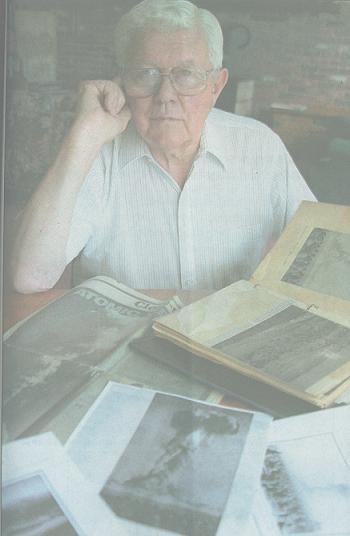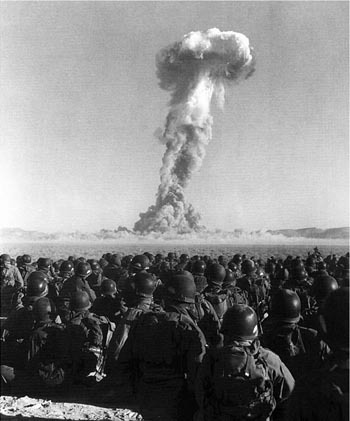 Saturday, November 4, 2006
Saturday, November 4, 2006'I was in a white world'
Witnessing an A-bomb test, Gordon Edwards' world stood still

Gordon Edwards was at Exercise Desert Rock when
the Dog Shot Bomb exploded for testing.
By Howard Huntington
of the Daily Courier
"I flinched. I had no idea how long it takes something to fall 30,000 feet. But it takes a long time." Cpl. Gordon Edwards didn't know bombs or atomic. He was infantry, but sat as ordered with his back to ground zero. "I remember relaxing and the thought went through my mind: They flew me roughly 2,000 miles and I'm sitting out here, and this thing's a dud.
"About that time, it detonated.
"I was in a white world," says Edwards, of the Shan Creek area today. "But white does not describe it. It was flaming white and seemed to last a long time. But maybe it was one of those surreal moments where 'time stood still.'
"I remember looking at my hands. I said, 'Stop it! Stop it!' My mind could not accept there was no more color in my world."
Only by a chance meeting many years later in California would Edwards fully understand the danger on that November morning in 1951 in Desert Rock, Nev. His daughter wanted to introduce him to a new friend. "I'm very sorry to be late," the friend said. "I was visiting my father in the hospital.
"He's dying of leukemia. He was at Desert Rock in '51. Nine of the 12 guys in his squad are all dying of leukemia."
The Korean War had broken out in 1950. Just as UCLA was placing a diploma in Edwards' outstretched palm, the Army slapped a draft notice in it.
Sixteen months later the Army volunteered him for an unspecified weapons demonstration, Operation Buster-Jangle. If it turned out to be a series of nuclear tests, "I thought, oh, boy! How many people get to see an atomic bomb?"
"There was never a question of not going. In the Army, you do what you're told."
Thousands of troops from his camp in Georgia and elsewhere converged on scratchy, lonesome Desert Rock. Edwards didn't know anyone there, even from his camp. Nobody seemed to know anybody. He thought that might be the plan, and they were all there for one purpose: to measure their reactions close-up to an atomic bomb. The Army wasn't saying much.
The Nov. 1 test was called Dog Shot. At 21 kilotons, it was one of the biggest detonations and the first involving U.S. troops.
Edwards figures he was about 5 to 7 miles from ground zero, getting orders by loudspeaker to sit facing away. "We didn't have dark glasses. We didn't have any earplugs — none of us," he says. "No protective anything."
But "I was not afraid of the morning of Nov. 1. It was more of a wonderment, you could say, of what was going to happen."
Then came "5, 4, 3, 2, 1, bomb away" from a Boeing B-50 zeroing on an X scratched in the desert floor.
At 7:30 a.m., Dog arrived at 1,417 feet and erupted.
When the flash passed and Edwards was getting back some color, "the loudspeaker said, 'OK, you can turn around now.' And we pivoted. It was like you had taken the sun at noon and put it at 1,400 feet," but more orange. "You couldn't look at it. "
A couple of guys started to stand up and the loudspeaker said, 'You'd better sit down! The concussion is gonna be here.'" The wave bowled down everyone standing and shoved Edwards into the dirt. "No big deal," he says. "There was no pain or broken bones or anything.

Soldiers watch Dog Shot detonate on
November 1, 1951 in Desert Rock, Nevada.
"...It went BOOM-BOOM, just like that," and broke windows 75 miles away in Las Vegas. "It would be like a bomb dropping in Roseburg and breaking my window here."
Dog, which evidently followed previous shots named Able, Baker and Charlie, turned dirty-brown, then white and thready as it rose and finally wandered off with some other high clouds. It was time for the troops to hit ground zero.
"If you'd been driving in northern Nevada and looked over two hours later, nothing would have told you this cataclysm had taken place," Edwards says.
There was no hole, no lingering fires, just a mile of blackened brush in all directions; scarecrows, a tank and other objects that had been placed around to see the effect; and sheep — still grazing contentedly in underground bunkers.
The spectacle convinced Edwards that the safest place for him in an atomic war would be the front line. No enemy would waste a bomb on dug-in troops. The Army said 2 feet of dirt would do it.
To his knowledge, Dog hadn't injured a soul. "It was quiet. We got back on the trucks and went back to Desert Rock. And a day or so later we got on a troop train and went back to Georgia."
Edwards lost some of his hearing, but is not sure he can blame Dog for it, or for the prostate cancer he developed 50 years later, even if it is one of five cancers associated with the blast.
He did report it to Veterans Affairs, but so far they've just pushed letters back and forth, he says. "They said, 'OK, well, let's wait and see.' It's been 5 years (since he was diagnosed), and I'm 77. I think they're waiting for me to disappear."
But his cancer is gone or in remission, and none of his three children has any apparent symptoms from Dog.
It's the "downwinders" — the unknowing civilian casualties — who still pain him. But who else, he asks, remembers "the Air Force dropped the same bomb on the United States that they dropped on Japan and ultimately killed thousands of Americans?
"Nobody knows about this."
To his children and their children, Edwards will bequeath Life magazine and newspaper clippings about Dog, and a long-classified Army film he says made it look like a Boy Scout outing.
The film explains the test was designed to dispel the fears of citizens and troops about atomic radiation, and shows soldiers being "decontaminated" by brooming dirt off them.
It ends unofficially with a scene Edwards tacked on from one of his favorite movies, "Dr. Strangelove or: How I Learned to Stop Worrying and Love the Bomb."
"I took it for what it was worth as a black comedy," he says. "I looked around, and people were laughing at the end of the world."